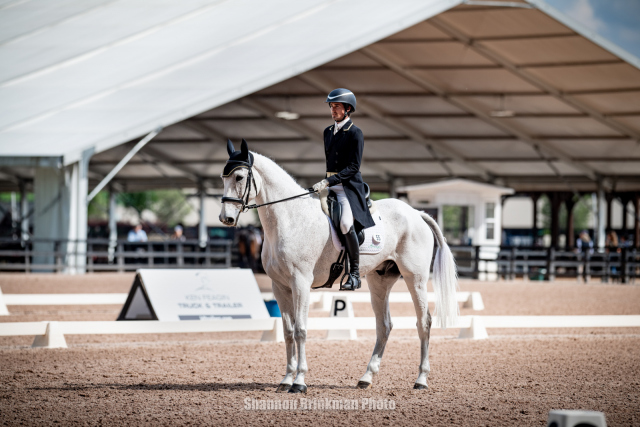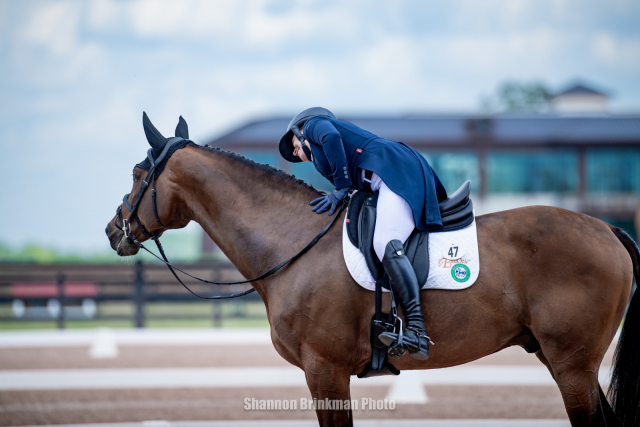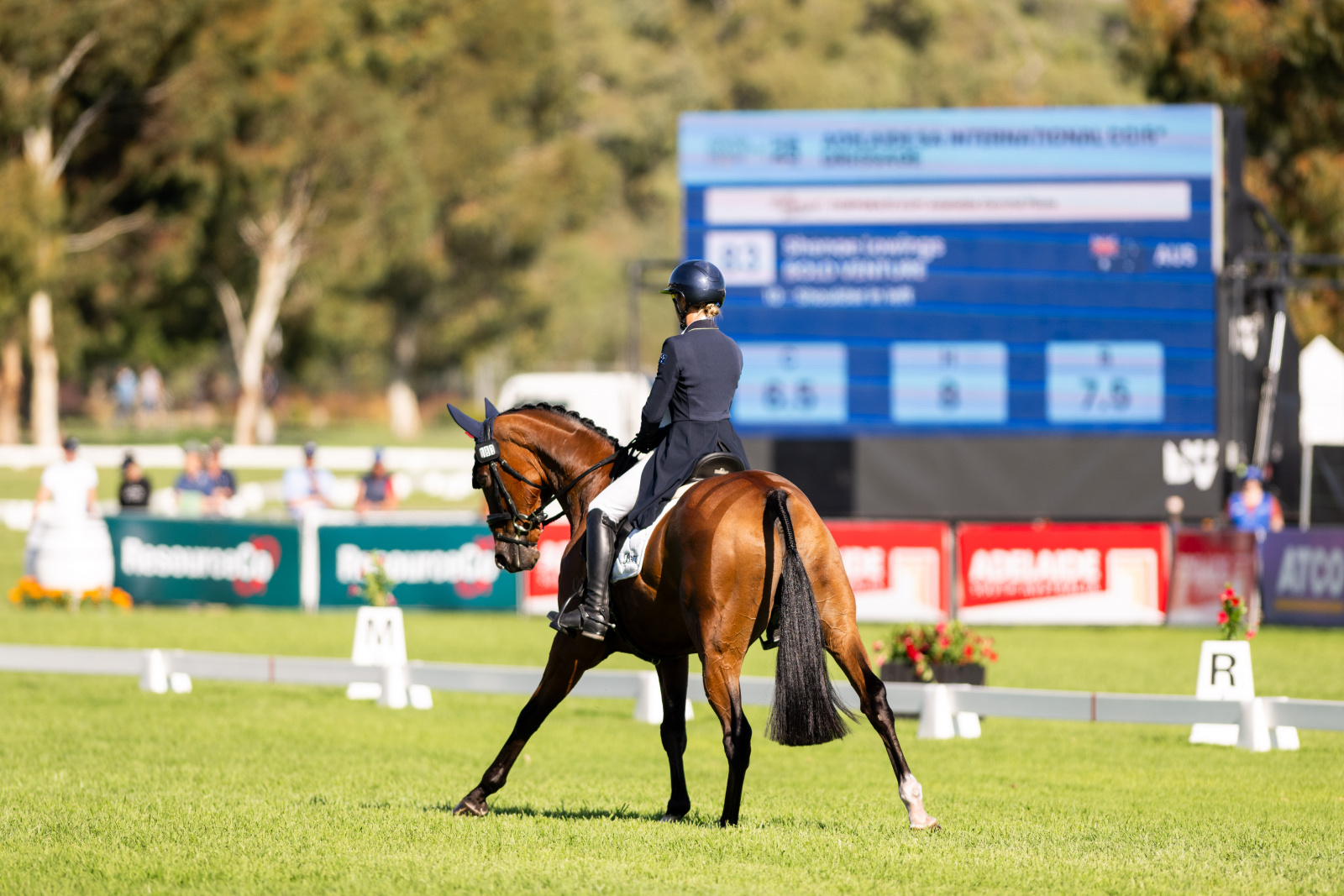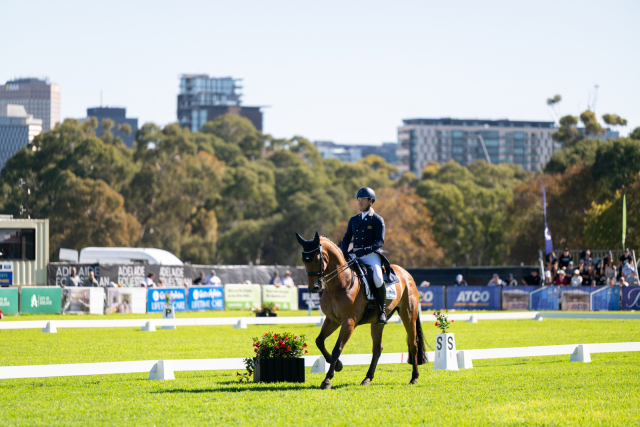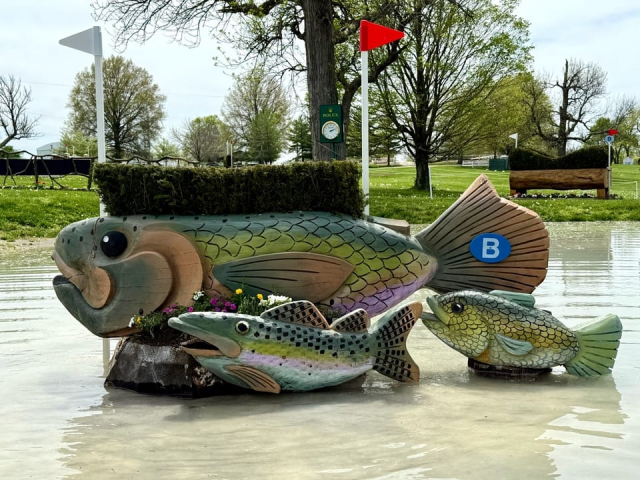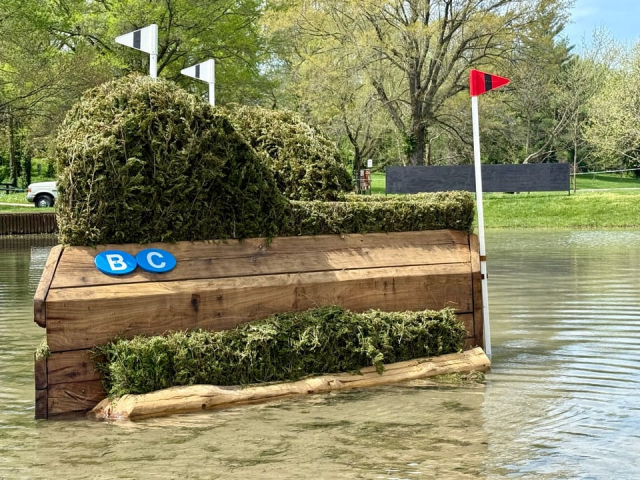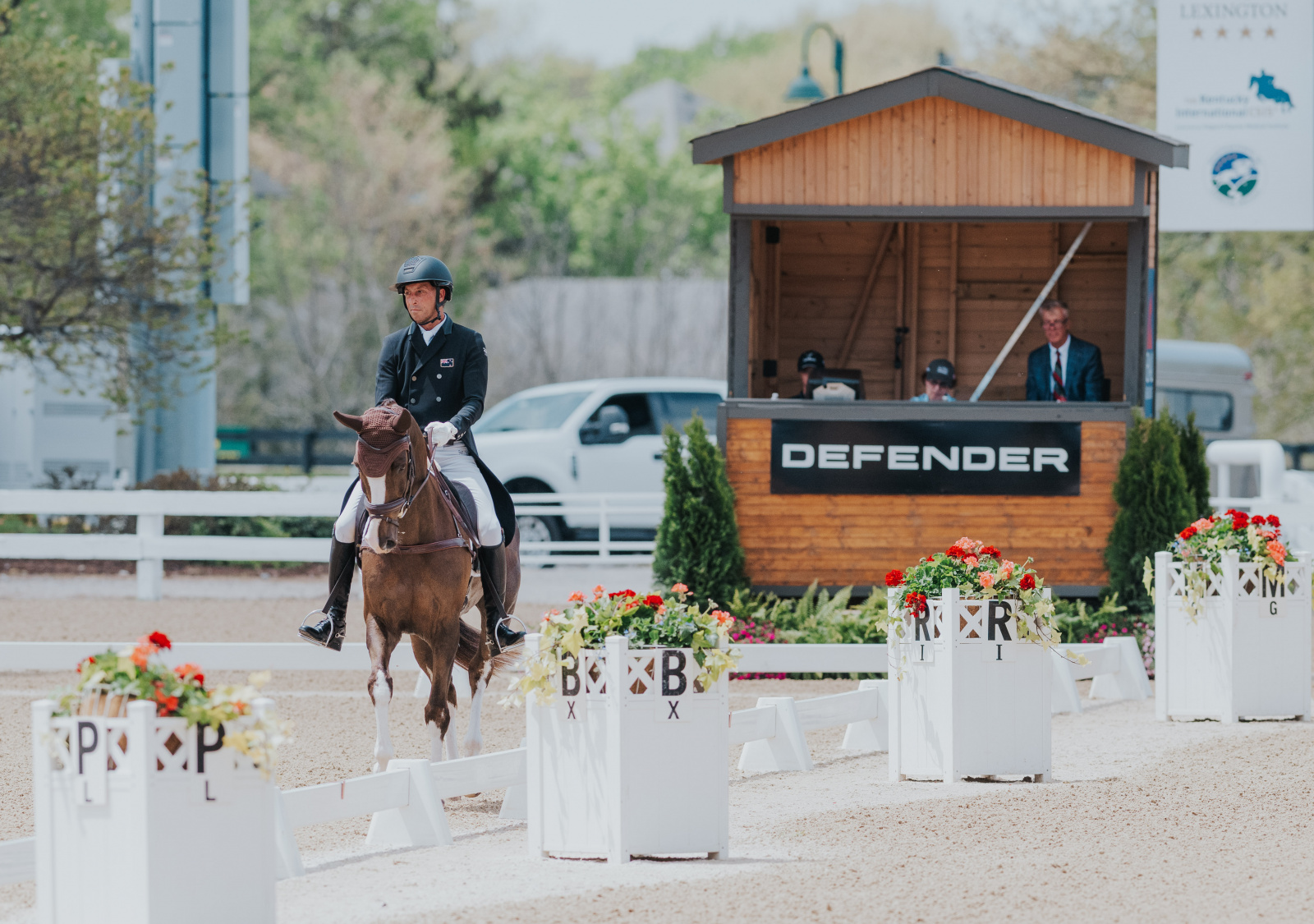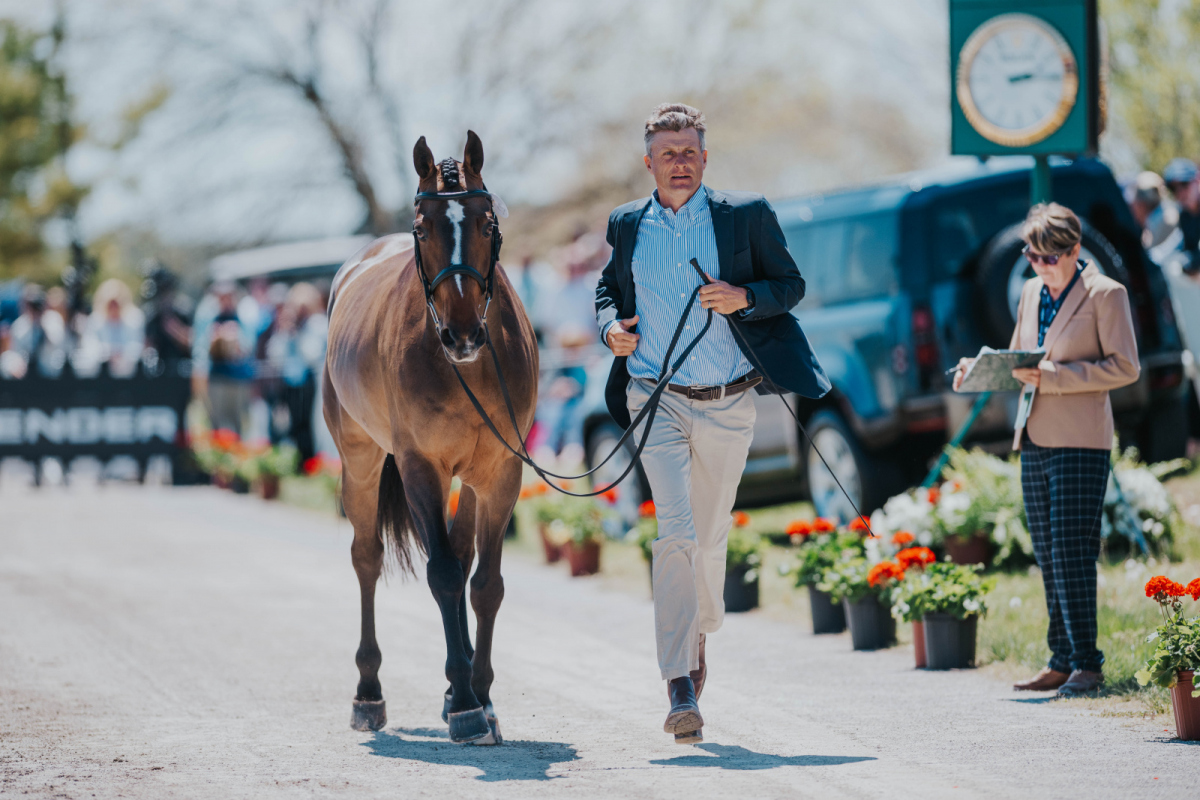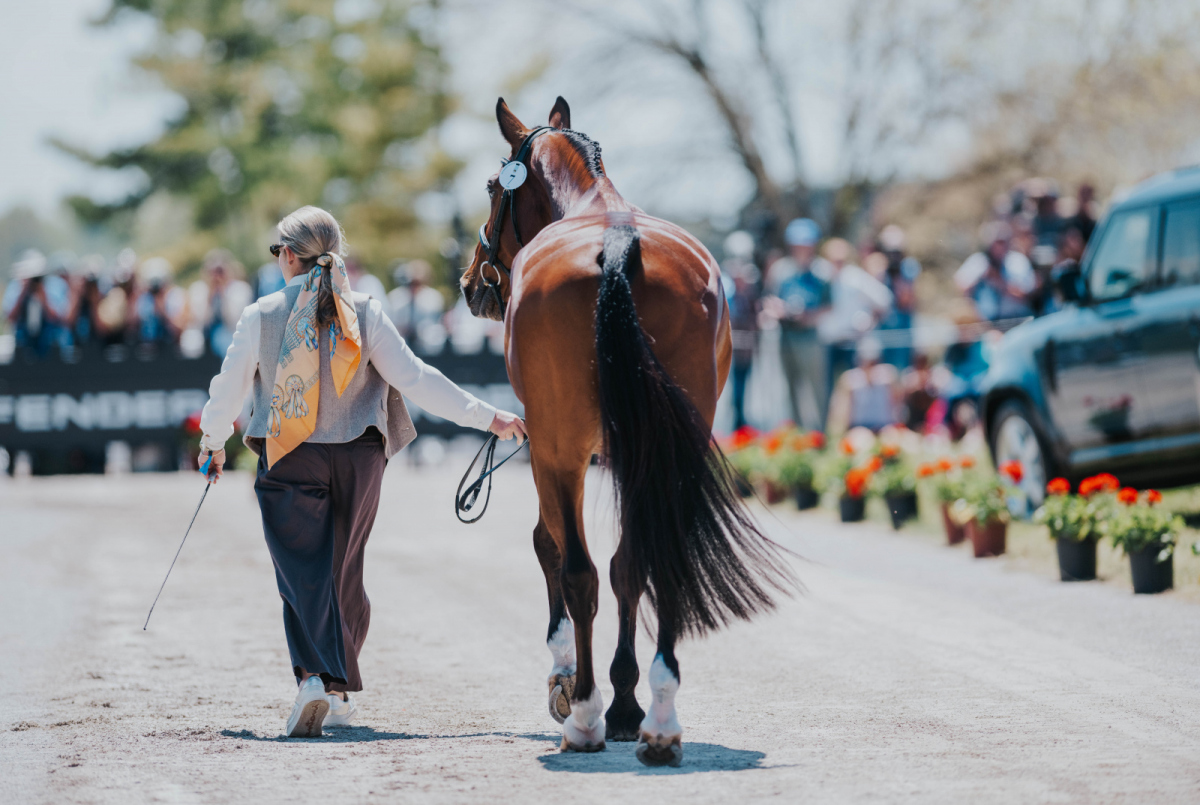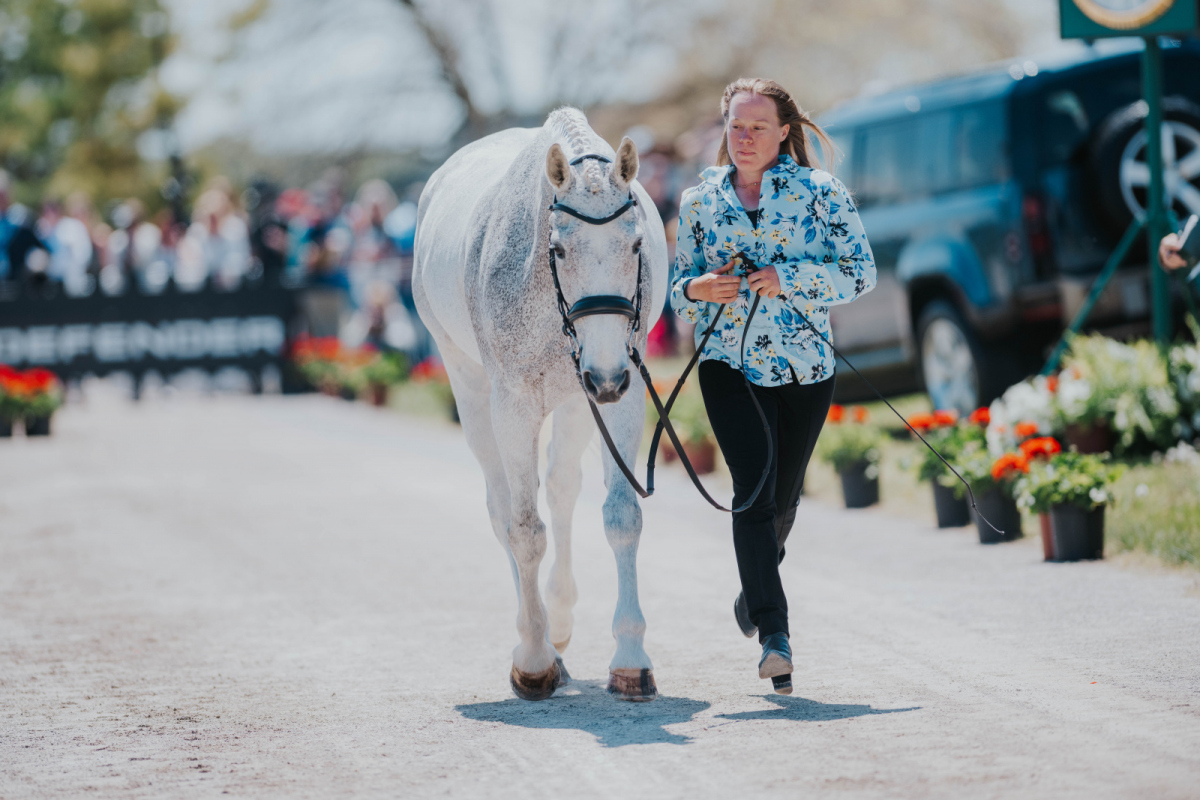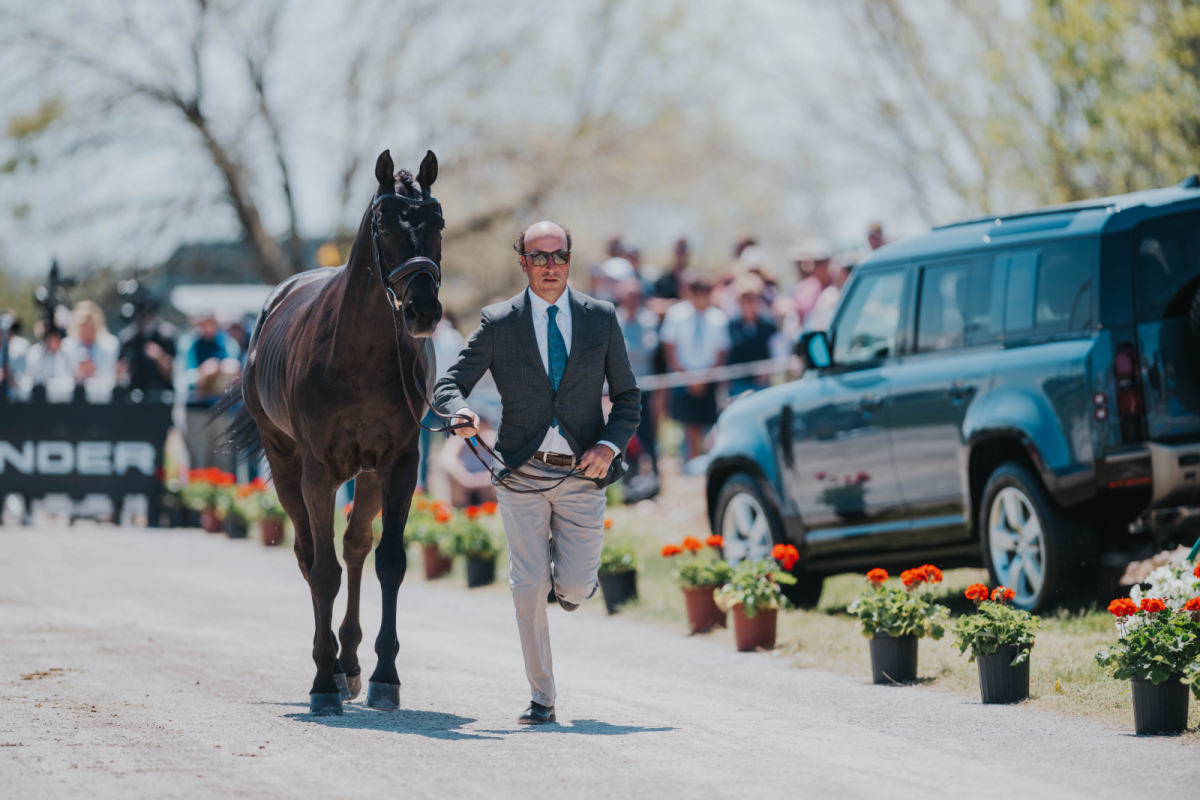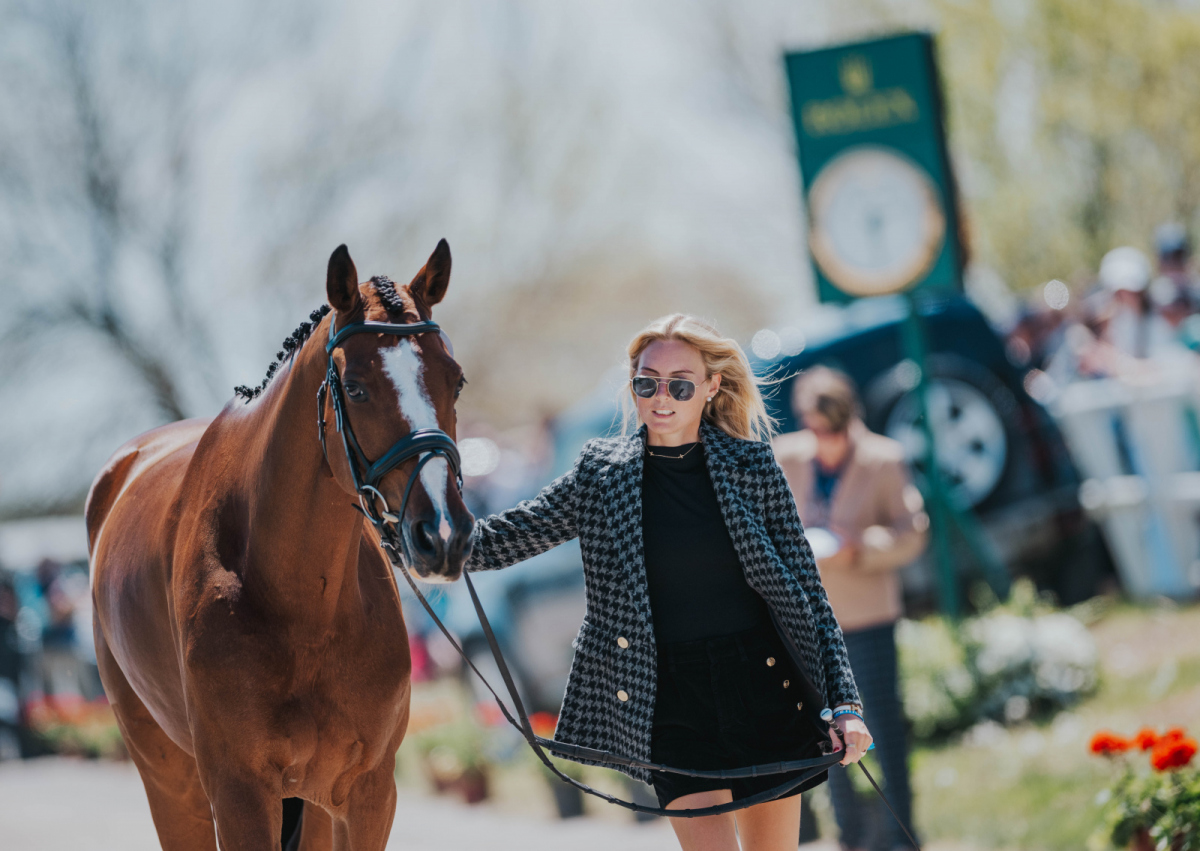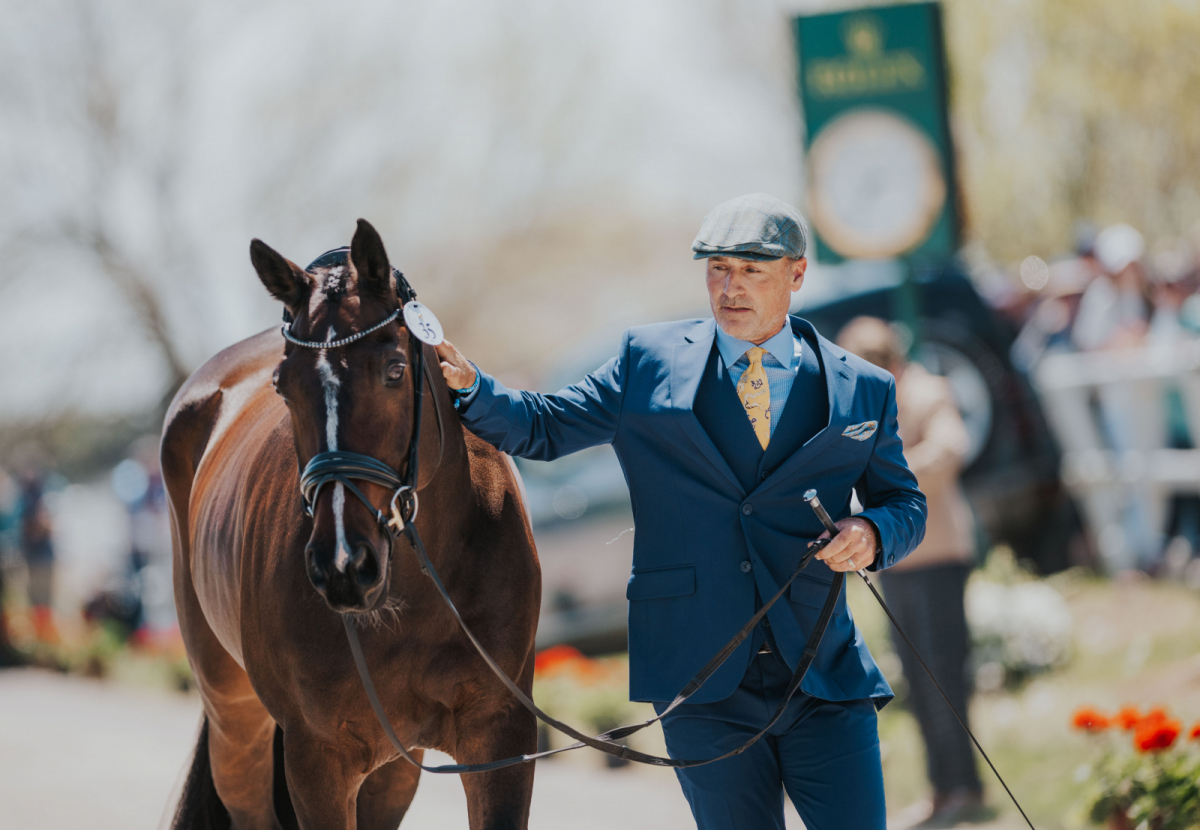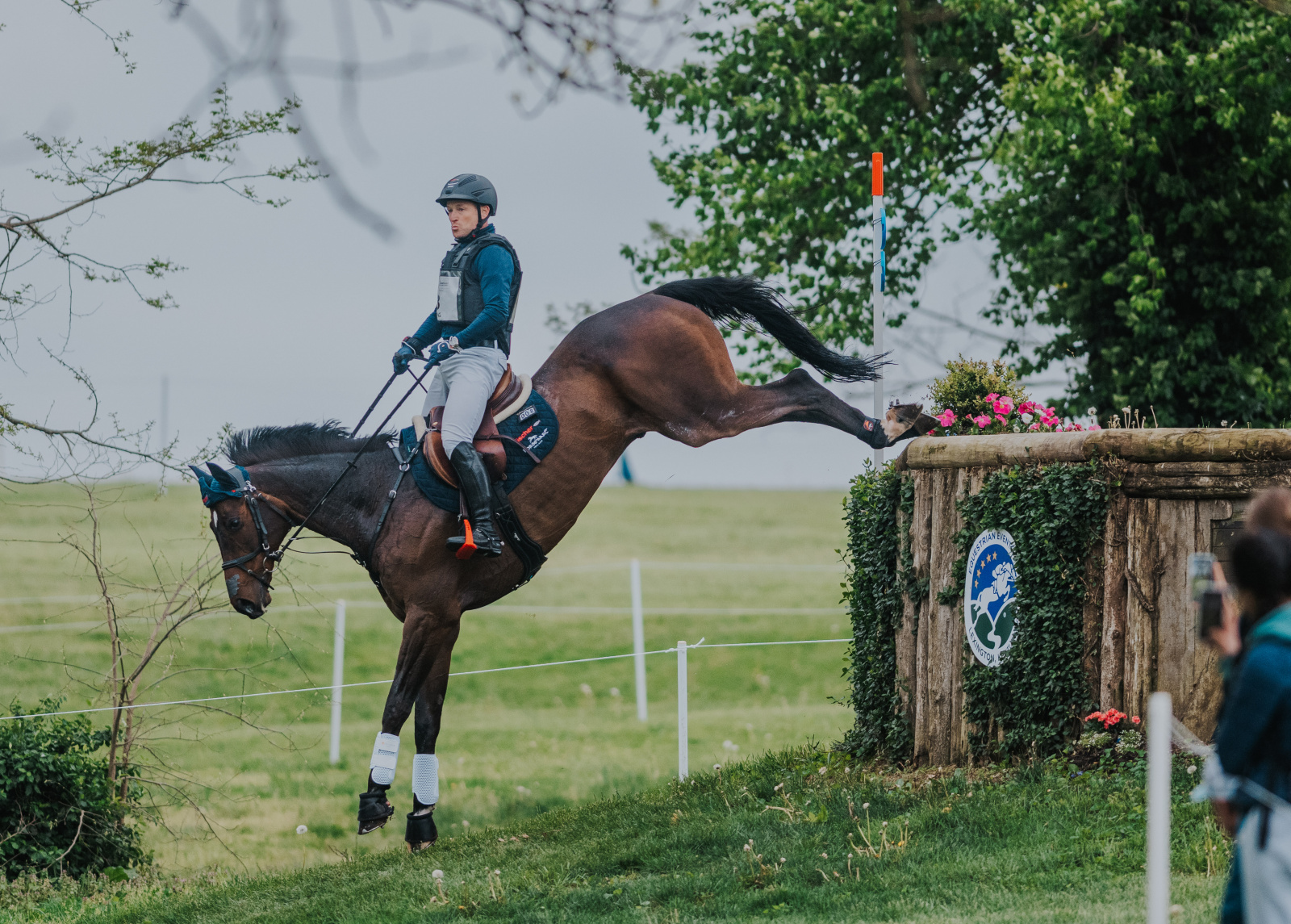
Michael Jung and fischerChipmunk FRH. Photo by Tilly Berendt.
We always come into a 5* cross country day with some of the same goals in mind, no matter which event it is. We want to see influence from the course, but in a way that doesn’t trap or confuse horses, and in a way that puts safety first, competitiveness second. Derek di Grazia has built (literally) a reputation for himself as a designer that thinks through the horses’ eyes. He’s clever as he sets his track, paying close attention to the ground and what part it could play in each question he asks of competitors. He strategically places roping and decoration to oblige riders into thinking as they ride. We also want to see influence exerted around the course as a whole, rather than heavily concentrated at one specific question, driving further home the point that every course has a cumulative effect, and should be viewed through the lens of a big picture in terms of how each piece integrates into the whole puzzle.
I believe this was accomplished today on cross country at the Defender Kentucky Three-Day Event, presented by MARS Equestrian.
The 5* ran in the afternoon, as is tradition since the inclusion of the Cosequin Lexington CCI4*-S beginning in 2021. The day seemed to pass in the blink of a crinkling eye, and with the appearance of Michael Jung and fischerChipmunk FRH (Contendro I – Havanna, by Heraldik) as just the sixth to see on the day, we knew it was a possibility that we’d know the overnight leader very early on in the going.
And so it went. Once more, the German reigning Olympic champions remained unthreatened today, and will take their lead forward into tomorrow. Michael came into today with the largest margin ever seen ahead of cross country at a 5* event, according to EquiRatings, and he needed some of his 18+ second cushion but stopped the clock with six seconds of time to go onto a two-phase score of 21.0. That will put him over his record finishing score of 20.1 achieved here in 2022 when he took the win, but he will have two rails in hand tomorrow over second-placed Boyd Martin and Commando 3 going into show jumping.
But Michael himself says (claims?) he isn’t altogether concerned with records and statistics. For him, it’s about enjoying yet another special partnership with a horse that’s helped him accomplish so much. “Honestly, I don’t think about the records too much,” Michael expressed. “I’m focused on each competition and each horse. Of course, it’s nice when the results are good, but my goal today was just to give my horse the best round possible — not to chase any particular record. I’m very happy with how it went, even with a few time penalties.”

Michael Jung and fischerChipmunk FRH. Photo by Tilly Berendt.
“It’s been a long time since I rode such a tough course, but I really believe in my horse,” he said just after his round today. As we reported yesterday, Michael spent the spring primarily competing in show jumping with this horse. In fact, besides schooling and galloping, Chipmunk had not run cross country since the Olympics, which happened last July. But, trust comes into play here. “I trust him completely. He’s a good runner, has so much scope, and he’s very experienced — he’s 17 years old now. I’m very, very lucky to have him.”
The softer ground from the moisture accumulated yesterday could have hampered Michael’s efforts to get home inside the time. Michael noted it was softer going than he anticipated (and truly, aside from some muddier spots where the crossing lanes were designated, the ground did feel fairly firm this morning), and that his horse did feel like he got somewhat tired. “I still get better and better with him together, still learning, but I think we had a great partnership, and that’s very important for the cross country,” he said. “He felt a bit tired on some places, so I give him the time, and I know I was behind the time, but he was really, really good galloping to the end of the course. So in the end, he was really fit to make it. And I’m very happy about today.”
As for Chipmunk’s show jumping, he’s both won and lost in this phase in the past. It’s difficult to imagine a scenario in which the horse does not do enough tomorrow to seal the win with two poles in hand; he’s not had more than one down in FEI competition since the World Championships in 2022. While he could lower one rail, it’d be rather surprising to see more than that. Of course, anything can happen at any time, but if you were a betting person, this one could be a fairly safe one. Should he take the win tomorrow, it will be his fifth here at Kentucky, not including the individual gold won at the World Equestrian Games held here in 2010.

Boyd Martin and Commando 3. Photo by Tilly Berendt.
Boyd Martin jumped an absolute all-class clear with Yankee Creek Ranch LLC’s Commando 3 (Connor 48 – R-Adelgunde, by Amigo xx) — that’s three clears on the day for Boyd, who will be thrilled with the efforts of these incredible horses. Commando 3 was potentially the most impressive of the bunch and was rewarded for his efforts to remain in USEF National 5* Champion position for tomorrow. Boyd didn’t catch the time on any of his horses, but “Connor” came closest, picking up just 6.8 penalties to go onto a score of 32.8.
“It was a bloody tiring day!” Boyd said. “Me and Tim Price were out there every ride sort of huffing and puffing away. But I had a good, strong day. I was probably a little bit cautious on Luke, and then I thought, ‘Come on, Boydie, you gotta toughen up a bit.’ And I went pretty quick on Connor. He’s a young, fit Holsteiner and he gave me a great round. It was a challenging course — the ground, I thought was a bit tiring, but I’m very pleased with the day.”

Boyd Martin and Luke 140. Photo by Tilly Berendt.
The Annie Goodwin Syndicate’s Fedarman B (Eurocommerce Washington – Paulien B, by Fedor) also jumped clear (he was initially given 15 penalties for a missed flag on course, but the penalty was later removed); Boyd noted that “Bruno” seemed to tire on course, but “I have so much admiration for him. Even when he got tired, he just kept pushing and kept trying — he never once looked like he wanted to give up or run out.” Bruno is in seventh tonight on a score of 40.2. Boyd also jumped clear on the Luke 140 Syndicate’s Luke 140 (Landos I – Omega VI, by Limbus), who returns to the 5* level for the first time since 2023 and will be in ninth ahead of tomorrow, picking up 16.8 time penalties but otherwise delivering a strong clear for Boyd as he ramps back up from his hiatus from the level. This puts all three of Boyd’s rides into the top 10 going into show jumping.
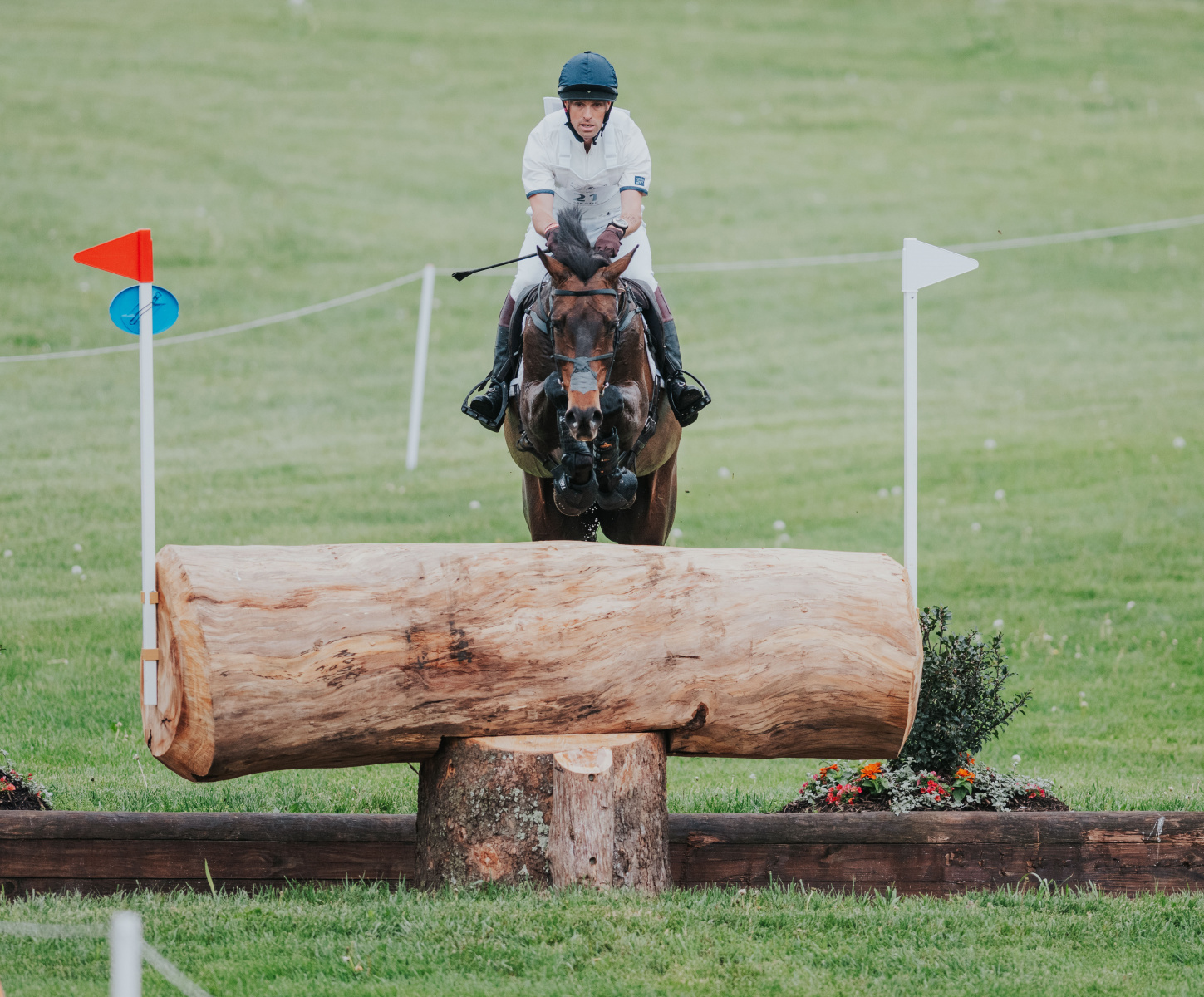
Harry Meade and Et Hop du Matz. Photo by Tilly Berendt.
Third overnight is Great Britain’s Harry Meade, who secured the sole clears inside the time today with both Et Hop du Matz (Nouma d’Auzay – Prima du Matz, by Easy Star), who climbed all the way from 17th after dressage, and Amanda Gould’s Grafennacht (Grafenstolz – Nachtigall, by Narew xx), who also leapt from 18th into 4th after an uncharacteristically high dressage mark yesterday that was well above her average — enough, Harry admits, that he considered not running the mare today up until about 11:30 this morning.
“I was confident they were fit,” Harry said. “I thought I’d just get out there and see. The first horse [Et Hop du Matz] I know really well. I always felt he’d be a really good country horse, and I hoped to be a really good five-star horse. And he was. He was great, very adjustable. The time could be tighter, the course could be longer, the going even softer, and he would have coped well with it. So we’re really happy with him.”

Harry Meade and Grafennacht. Photo by Tilly Berendt.
“I don’t really know [Grafennacht] very well,” he continued about his second ride. “We’ve only really, I guess, had this spring to get to know each other, and we had what we had run out in Italy to qualify to come here. I wasn’t even thinking about coming here. I thought I’d go out and do that event and then reflect afterwards. And she won it by quite a big margin of 24 penalties, and I sort of thought, well, it’s a bit of a no brainer to bring her here.”
Despite those plans, though, Harry had little chance to actually cross country school the 13-year-old Oldenburg mare due to ground conditions and other factors. Harry knew that “Lillie” didn’t prefer to get too close of a distance to the fences, so he focused on allowing her to stand off from them a bit more and gave her “a bunch of space” to get the job done. He opted to go long at the Defender Head of the Lake, knowing he was up on the clock at that point just over halfway around the track. “I had to work super hard to get back up on the clock [after that],” Harry said.

Tom McEwen and Brookfield Quality. Photo by Tilly Berendt.
British Olympic gold medalist Tom McEwen moved into fifth with Brookfield Quality (OBOS Quality 004 – Bay Coffey Cavalier, by Cavalier Royale), who jumped clear and added 10.4 time to yield some placings from his initial third place after dressage, but nonetheless still landing in the top five ahead of show jumping. “Norris was actually class,” Tom said of the 16-year-old Irish gelding owned by Chloe & John Perry & Alison Swinburn. “He’s unique in every way — as straight as the day is long — and he’ll do absolutely anything for you. He really sorts his legs out well.”
Tom set out determined to catch the time, though it wasn’t quite meant to be. “I was absolutely determined to make the time and be as smooth as I could,” he said. “Just like I imagine Harry was. I saw [Michael] trying as well. Sometimes you just have to react quickly when something happens in front of you. The only thing I might second-guess about my ride is the decision at the last combination. Maybe I should have gone straight through it. He was starting to feel a little tired at that point, and even though I know he probably could have made three strides there — because it was long, too — I just thought maybe we were slightly under-prepared to ask that much from him at that moment. So I thought, ‘you know what? He’s tried hard enough. Let’s give him a nice, smooth journey home.’ And honestly, he jumped brilliantly on the way back anyway. He was absolutely fantastic. There were some individual moments that were just brilliant.”

Tim Price and Jarillo. Photo by Tilly Berendt.
It was a mixed-bag day for New Zealand’s Tim Price, whose first ride, Jarillo (Dantos – Fiorilla, by Alicante), will be the top-placed of his three tonight, sitting in sixth on a score of 40.0 after jumping a strong clear as the pathfinder on the day. This horse is contesting his second 5* after finishing in the top 10 at Pau last year. “He’s really gaining the ability to dig himself out of a few green moments, and that’s definitely what he did today,” he said. “I thought he actually stayed really brave, trying to keep going even when things got a bit tricky. He’s just going to take so much away from this experience. It’s going to set him up really well for the future. I’m really proud of him.”
Tim’s second ride, Happy Boy (Indoctro – W. Amelusina 17, by Odermus R), was pulled up on course after the Ground Jury thought they may have seen some blood on the horse. It was assessed and determined that there was no blood, and Tim was allowed to carry on, but he expressed some frustration at the events. “I had just jumped through cleanly through the [Cosequin Cove] when they waved me down,” he said. “It was a bit unreasonable, honestly — they thought they saw some blood, but it turned out to be nothing, so they let us carry on. Anyway, he got a lot out of it.” Happy Boy also activated a frangible pin at fence 11 and went on to have two other refusals on course, but he did complete, and this marks his first 5* cross country completion after two previous attempts from which he was withdrawn before he could run cross country.
Then came the turn of Falco (Cardenio 2 – Witta, by Weinberg), Tim’s Olympic partner, who had a bit of a surprising 20 at the C element of the Cosequin Cove after he slightly pecked on landing after the B element. “[We were up] on the time, everything was going well, but unfortunately at that same water, the ground had shifted slightly lower where we landed off the first element,” Tim explained. “Being such a deliberate and careful jumper — not like an old-school eventer that would just throw themselves over no matter what — he just got caught at a half-stride and put in a little stop. We came back, re-approached, and he jumped it beautifully the second time.”

Shannon Lilley and Eindhoven Garette. Photo by Tilly Berendt.
Our top-placed rookie of the day is Cassie Sanger with Redfield Fyre, who did miss a flag at the Normandy Bank but will be in 17th after cross country. Shannon Lilley was the sole rookie to go jump penalty-free on cross country, taking her time and picking up some 30 time but nonetheless making a great and long-awaited debut at the level with Eindhoven Garette (Iowa 960 – Rose Rouge Garette, by Manillon Rouge). She is in 19th after today.
It was an intense day of cross country, with problems frankly popping up all over Derek di Grazia’s 11 minute, 20 second track. We saw everyone from vastly experienced pairs to more unproven competitors having trouble all over. We knew Derek had thrown a good amount of narrow, skinny fences on, and the trouble showed up in no less than three riders collecting missed flag penalties worth 15 points each.

Emily Hamel and Corvett. Photo by Tilly Berendt.
Runout/refusal penalties were assessed at multiple fences, but a handful proved to be the most influential in terms of problems. Fence 14, Pete’s Hollow at the highest point of the course, caught out four pairs, primarily at the C element off an aggressive right turn from one a skinny triple bar to another. Three pairs had runouts here, and one other, Jennie Brannigan and FE Lifestyle, opted to retire at the A element. Fence 20, the Normandy Bank, also exerted its influence with three 20-penalty problems occurring at the C element, a severely angled brush off the direct route from the bank and cabin elements on top of the complex. Another pair, rookie competitor Cassie Sanger with Redfield Fyre, picked up 15 at the C element for a missed flag. Fence 22, the Cosequin Cove, saw four pairs encounter trouble, with two pairs picking up 20 at the B element and two others having trouble with the C element, both of which were skinny brush arrowheads.
In terms of time, just two pairs, both piloted by Harry Meade, flew home to catch the time. Et Hop du Matz was the first to do it, in a time of 11:18, while the former William Fox-Pitt ride, Grafennecht, finished in 11:19. Michael was the next fastest with his 2.4 time penalties, and Boyd Martin also collected fewer than 10 time penalties (6.8) with Commando 3, but all other pairs accumulated over 10 time penalties. The time at any 5* is always difficult to make, but today the course certainly exerted its influence on the clock. This year’s track had a 6% clear inside the time rate — the same as 2024’s course, which also saw just two riders go inside the time. 48% of the field jumped clear, and the course saw a total 78% completion rate, which is a tick down from the 2024 81% and change completion rate (but it’s a little deceiving, as the 2024 course also saw 26 completions, with one less starter than today’s 33).

Libussa Lübekke and Caramia 34 are 10th after cross country. Photo by Tilly Berendt.
And truly, in many ways (and on paper, at least), the course was as influential as any — but safety reigned supreme. We had zero horse falls (though, okay, to be fair a couple came close) and just one rider fall in the 5*; rather, the influence came from the clock (which was likely affected in some ways by the ground, which some riders described as a little soft and holding, but not sloppy or slick after yesterday’s downpour and some additional watering that was done earlier in the week, and the questions that caused trouble in the form of runouts or refusals. It’s the type of influence we love to see on these tracks, and it’s a great example of smart designing and good decision-making on the part of the riders.
Derek di Grazia agreed. “I’m particularly satisfied,” he said. “You never know at the beginning of the day, obviously, what’s going to happen. And you put together a course, and you hope it’s going to provide a good competition. And I think that the first thing I always am happy about it was the fact that horses walked home today. Everybody walked home. We only had two rider falls in the four-star class. We had one in the five-star class. And to me, that’s a good day. Lots of little run outs here and there on the courses, different in lots of different places. So to me, overall, I think that it provided good competition.”

Boyd Martin and Fedarman B. Photo by Tilly Berendt.
I thought Boyd summed up the mental game that is eventing — particularly on cross country day — quite well, and I’ll end with his thoughts:
“I don’t sleep that build the night before. I’m trying to go through the course and trying to make sure that I understand how I want to jump each jump. And as you get closer and closer, for me, you’ve got to sort of make a deal with yourself that you’re going to have a crack at it, because it’s very easy to sort of talk yourself out of not going for it. And I find leading up to the cross country, I’m always saying, ‘What the hell am I doing this for?’ And then when you finish it, you’re like, ‘Okay, where’s the next one?’ It’s an emotional roller coaster. And I think the last thing I’d say is you’ve got to become a good loser in this sport, because you’ll lose a lot more times than you win. And like these two other guys said, we all get into this sport all because we love horses. So we love competition, and your career is so long and strung out — many athletes would be well retired by the time they’re our age, and it’s a long process. Finding enjoyment in not just the contest, it’s the building the horses up and bringing them to this level that’s a real feel of satisfaction that you’ve trained your horse to get to this place.”
True words indeed, and a reminder for us all. We’ll see you tomorrow bright and early for the final trot-up at 8 a.m., which will begin with an inspection of the 4* horses, followed by the 5* horses. Thanks for following along, and Go Eventing.
Defender Kentucky: [Website] [Tickets] [Official Schedule] [Entries & Ride Times] [Scoring] [XC Maps] [ClipMyHorse Live Stream] [USEF Network on ClipMyHorse Live Stream] [EN’s Coverage] [EN’s Form Guide]
EN’s coverage of Defender Kentucky is supported by Kentucky Performance Products. To learn more about Kentucky Performance Products’ science-backed nutritional support products, click here.




























